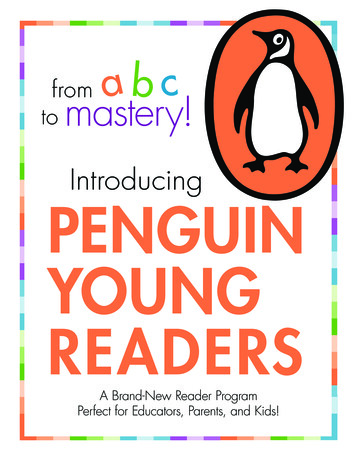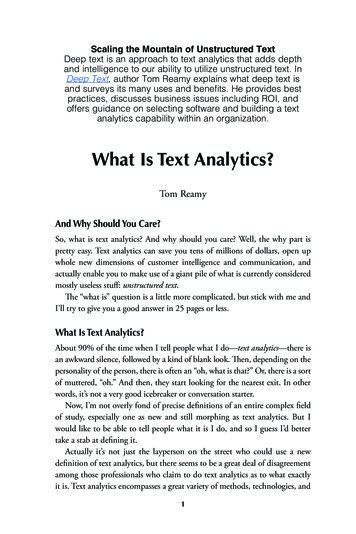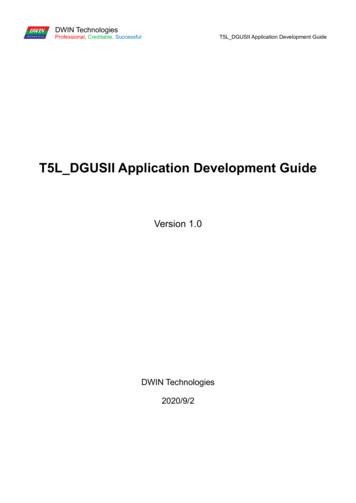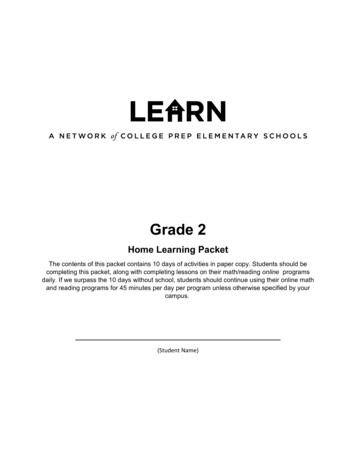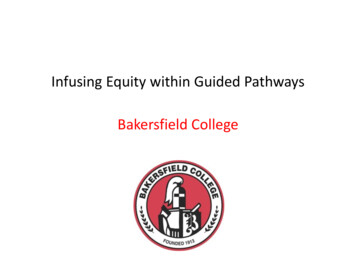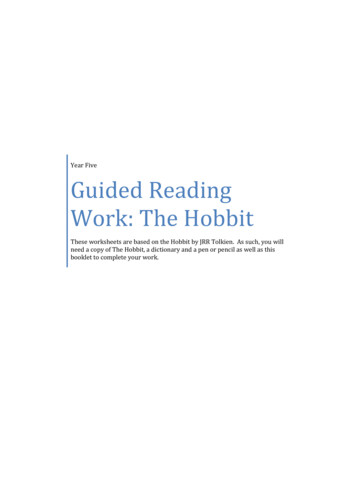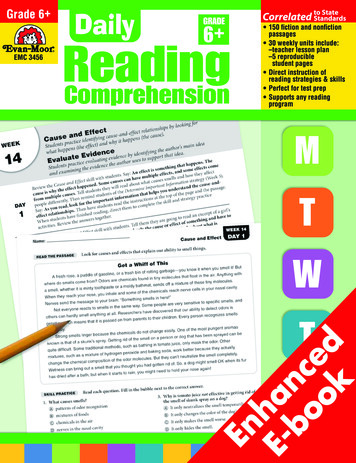
Transcription
Grade 6 EMC 3456GRaDe6 to StateCorrelated Standards 150 fiction and nonfictionpassages 30 weekly units include:–teacher lesson plan–5 reproduciblestudent pages Direct instruction ofreading strategies & skills Perfect for test prep Supports any readingprogram
Correlatedto State StandardsVisitThis book is also availablein a consumable studentpractice book edition.www.teaching-standards.comto view a correlation ofthis book’s activitiesto your state’s standards.This is a free service.Benefit from the same targeted skills practicein a time- and money-saving format.Save moneyConsumable books reduce the cost of copyingto your school by at least 30%.Save timeSay goodbye to copying, collating, and stapling,and save at least 30 minutes a week.Save student workStudent practice books work great as studentportfolios and give you easy access to a recordof each student’s skill acquisition.Daily Reading ComprehensionStudent Practice Books160 pages in each individual book.Student Practice Books are soldin 5-packs.Grade 1EMC 6631-PROGrade 2EMC 6632-PROGrade 3EMC 6633-PROGrade 4EMC 6634-PROGrade 5EMC 6635-PROGrade 6 EMC 6636-PROStudent practice books are a sole source productand are only available for purchase directly fromEvan-Moor Educational Publishers. To purchasestudent books, visit www.evan-moor.com.
Thank you for purchasingan Evan-Moor e-book!Attention Acrobat Reader Users: In order to use this e-book you need to haveAdobe Reader 8 or higher. To download Adobe Reader for free, visit www.adobe.com.Using This E-bookThis e-book can be used in a variety of ways to enrich your classroom instruction.You can: engage students by projecting this e-book onto an interactive whiteboard save paper by printing out only the pages you need find what you need by performing a keyword search and much more!For helpful teaching suggestions and creative ideas on how you can use the features ofthis e-book to enhance your classroom instruction, visit www.evan-moor.com/ebooks.User AgreementWith the purchase of Evan-Moor electronic materials, you are granted a single-userlicense which entitles you to use or duplicate the content of this electronic book foruse within your classroom or home only. Sharing materials or making copies foradditional individuals or schools is prohibited. Evan-Moor Corporation retains fullintellectual property rights on all its products, and these rights extend to electroniceditions of books.If you would like to use this Evan-Moor e-book for additional purposes notoutlined in the single-user license (described above), please visitwww.evan-moor.com/help/copyright.aspx for an Application to Use CopyrightedMaterials form.
This page intentionally left blank
GRADE6 Writing: Bonnie BrookCommunicationsContent Editing: Marilyn EvansJames SpearsCopy Editing: Carrie GwynneArt Direction: Cheryl PuckettCover Design: Cheryl PuckettDesign/Production: Carolina CairdArynne ElfenbeinYuki MeyerOlivia TrinidadEMC 3456Congratulations on yourpurchase of some of thefinest teaching materialsin the world.Photocopying the pages in this bookis permitted for single-classroom use only.Making photocopies for additional classesor schools is prohibited.For information about other Evan-Moor products, call 1-800-777-4362,fax 1-800-777-4332, or visit our Web site, www.evan-moor.com.Entire contents 2010 EVAN-MOOR CORP.18 Lower Ragsdale Drive, Monterey, CA 93940-5746. Printed in USA.Correlatedto State StandardsVisit teaching-standards.com to view acorrelation of this book’s activities to yourstate’s standards. This is a free service.CPSIA: Worldcolor Dubuque, 2470 Kerper Boulevard, Dubuque, IA USA. 52001 [7/2010]3456.indb 16/25/10 1:48 PM
ContentsWeekStrategies and SkillsPage1Comprehension Strategy:Monitor Comprehension102Comprehension Strategy:Make Connections163Comprehension Strategy:Visualization224Comprehension Strategy:Organization285Comprehension Strategy:Determine Important Information346Comprehension Strategy:Ask Questions407Comprehension Skills:Main Idea and Details, SequenceComprehension Strategies: Monitor Comprehension, Visualization468Comprehension Skills:Cause and Effect, Evaluate EvidenceComprehension Strategies: Determine Important Information, Ask Questions529Comprehension Skills:Compare and Contrast, Make InferencesComprehension Strategies: Make Connections, Organization5810Comprehension Skills:Character and Setting, ThemeComprehension Strategies: Monitor Comprehension, Visualization6411Comprehension Skills:Author’s Purpose, PredictionComprehension Strategies: Ask Questions, Make Connections7012Comprehension Skills:Nonfiction Text Features, Visual InformationComprehension Strategies: Determine Important Information, Organization7613Comprehension Skills:Main Idea and Details, SequenceComprehension Strategies: Monitor Comprehension, Visualization8214Comprehension Skills:Cause and Effect, Evaluate EvidenceComprehension Strategies: Determine Important Information, Ask Questions8815Comprehension Skills:Compare and Contrast, Make InferencesComprehension Strategies: Make Connections, Monitor Comprehension9423456.indb 2Daily Reading Comprehension EMC 3456 Evan-Moor Corp.6/25/10 1:48 PM
WeekStrategies and Skills16Comprehension Skills:Character and Setting, ThemeComprehension Strategies: Monitor Comprehension, Visualization10017Comprehension Skills:Author’s Purpose, PredictionComprehension Strategies: Ask Questions, Make Connections10618Comprehension Skills:Nonfiction Text Features, Visual InformationComprehension Strategies: Determine Important Information, Organization11219Comprehension Skills:Main Idea and Details, SequenceComprehension Strategies: Monitor Comprehension, Visualization11820Comprehension Skills:Cause and Effect, Evaluate EvidenceComprehension Strategies: Determine Important Information, Ask Questions12421Comprehension Skills:Compare and Contrast, Make InferencesComprehension Strategies: Make Connections, Organization13022Comprehension Skills:Character and Setting, ThemeComprehension Strategies: Monitor Comprehension, Visualization13623Comprehension Skills:Author’s Purpose, PredictionComprehension Strategies: Ask Questions, Make Connections14224Comprehension Skills:Nonfiction Text Features, Visual InformationComprehension Strategies: Determine Important Information, Organization14825Comprehension Skills:Main Idea and Details, SequenceComprehension Strategies: Monitor Comprehension, Visualization15426Comprehension Skills:Cause and Effect, Evaluate EvidenceComprehension Strategies: Determine Important Information, Ask Questions16027Comprehension Skills:Compare and Contrast, Make InferencesComprehension Strategies: Make Connections, Organization16628Comprehension Skills:Character and Setting, ThemeComprehension Strategies: Monitor Comprehension, Visualization17229Comprehension Skills:Author’s Purpose, PredictionComprehension Strategies: Ask Questions, Make Connections17830Comprehension Skills:Nonfiction Text Features, Visual InformationComprehension Strategies: Determine Important Information, Organization184 Evan-Moor Corp. EMC 3456 Daily Reading Comprehension3456.indb 3Page36/25/10 1:48 PM
How to Use Daily Reading ComprehensionDaily Reading Comprehension provides a unique integration of instruction and practice in bothcomprehension strategies and comprehension skills.Strategies—such as visualizing or asking questions—are general, metacognitive techniques thata reader uses to better understand and engage with the text. Skills—such as finding a main idea oridentifying a sequence of events—focus on particular text elements that aid comprehension. Seepage 6 for a complete list of strategies and skills covered in Daily Reading Comprehension.The first six weeks of Daily Reading Comprehension introduce students to comprehensionstrategies they will apply throughout the year. Weeks 7–30 focus on specific skill instruction andpractice. All 30 weeks follow the same five-day format, making the teaching and learning processsimpler. Follow these steps to conduct the weekly lessons and activities:STEP 1The weekly teacher page lists the strategy or skills that students will focus on duringthat week and provides a brief definition of the strategy or the skills. Read thedefinition(s) aloud to students each day before they complete the activities, or promptstudents to define the skills themselves. You may also wish to reproduce thecomprehension strategy and skill definitions on page 8 as a poster for your classroom.STEP 2The teacher page provides an instructional path for conducting each day’s lesson andactivities. Use the tips and suggestions in each day’s lesson to present the skills andintroduce the passage.STEP 3Each student page begins with directions for reading the passage. These directionsalso serve as a way to establish a purpose for reading. Help students see theconnection between setting a purpose for reading and improving comprehension.STEP 4Because much of reading comprehension stems from a reader’s backgroundknowledge about a subject, take a moment to discuss the topic with students beforethey read a passage. Introduce unfamiliar phrases or concepts, and encouragestudents to ask questions about the topic.STEP 5After students have read a passage, two comprehension activities give students anopportunity to practice the strategies and skills. In weeks 1–6, the first activity is anopen-ended writing or partner activity that encourages students to reflect on thereading process, applying the weekly strategy. The second activity provides fourmultiple-choice items that practice the week’s skills in a test-taking format.In weeks 7–30, students complete the multiple-choice skill activity before practicingthe strategy activity. The teacher page for these weeks offers suggestions for teachingthe skills and gives tips for reminding students of the strategy(ies). Throughout theweek, use the Student Record Sheet on page 9 to track student progress and to notewhich skills or strategies a student may need additional practice with.43456.indb 4Daily Reading Comprehension EMC 3456 Evan-Moor Corp.6/25/10 1:48 PM
Weekly Teacher PageVisualizationWEEKVisualization allows readers to form mental images of what they are readingabout. By visualizing, good readers can better remember the main ideas or eventsin a passage. Good readers use sensory words from the text to help them visualizeand adjust their mental images as they read.3Weekly skills are explained atthe top of each teacher page.Introduce the Visualization strategy to students. Explain: When good readers read, they oftenmake mental pictures of what they are reading about. They turn what they are reading into akind of “movie” that plays in their mind. But this doesn’t mean they daydream. They payattention to important and descriptive words. Tell students to close their eyes and visualize as youread the first four sentences of the first paragraph. Read the sentences slowly to give students timeto understand and visualize the important descriptions (evergreen forests; covered in clouds;located on mountains; cool temperatures that create clouds covering the trees). Direct students toread the passage and to complete the strategy and skill practice activities. Review the answerstogether.DAY1Remind students of the Visualization strategy. Say: It’s important to look for words we can easilypicture. Read the first sentence from the passage aloud. Ask: Which is easier to picture: Sunday,airwaves, or kids? (kids) That’s because a kid is something we can see. When you visualize, lookfor words that represent something physical or concrete. Have students read the instructions atthe top of the page and the passage. When students have finished reading, use a world map or globeto help them find all of the nations mentioned in the passage. Then direct students to complete thestrategy and skill practice activities. Review the answers together.DAY2Remind students of the Visualization strategy. Say: When you visualize as you read, it isimportant to adjust your mental image when you get new information. Imagine that you arereading a story about a black kitten. You might picture a small kitten. If you then read the kittenwas the size of a firetruck, you’d need to change your mental image to match the details in thestory. Direct students to read the passage and to complete the strategy and skill practice activities.Review the answers together.DAY3The daily instruction path providessuggestions for modeling the skilland guiding students through thepassage and activities.Remind students of the Visualization strategy. Say: Good readers pay attention to the words in apassage. Specific action words—or verbs—and clear describing words—or adjectives—help usmake mental images as we read. Which is a better verb, go or shuffle? (shuffle) Which is a cleareradjective to describe french fries, good or salty? (salty) Have students read the instructions at thetop of the page and then read the passage. When students have finished reading, direct them tocomplete the strategy and skill practice activities. Review the answers together.DAY4Remind students of the Visualization strategy. Say: It may be easy for you to make a mental imageof what you are reading, but as a good reader, you must make sure to visualize only the mostimportant ideas or actions in a passage or story. It’s impossible to make a mental image ofeverything you read. Point out the first sentence in the last paragraph. Ask: Do you think it’simportant to visualize scientists sitting around having a debate? (no) Say: You should visualizethe parts of the passage that support what the passage is mostly about. Then have students readthe instructions at the top of the page and the passage. When students have finished reading, pairthem for the strategy practice activity or complete it as a group. Prompt students to defend theirchoices of what they visualized from the passage. Then direct students to complete the skill practiceactivity. Review the answers together.DAY522Daily Reading Comprehension EMC 3456 Evan-Moor Corp.WEEK 3Name:VisualizationREAD THE PASSAGEDAY 3As you read, adjust your mental image when you come across new details.Not Quite the SameName:When most people want to see what they look like, they look in a mirror. I don’t need a mirror to seeVisualizationmyself, though. I can just look at my identical twin sister, Sarita.WEEK 3DAY 2Daily Student PagesPASSAGEfor wordsthatway—longhelp you forma mentalwithpicture.SaritaREADand ITHEhavealways wornLookour hairthe sameand straight,bangs. We have thesame dark eyes and big smile, and we both have one crooked tooth on the right. We both love the colorTaketheAirwavesgreen, hate eating fish, and think mayonnaise isKidsdisgusting.Wetoplaythe violin,and every year we competeName:with each other forof firstinviolinin theschoolOnthethepositionfirst SundayMarcheachyear, orchestra.kids get to take over the world’s airwaves. The United NationsIn some Children’sways, however,we’re totallydifferent.Saritaalwayswearsfunky hats, whichI thinkis reallyFund (UNICEF)hasdesignatedthatday asthe InternationalChildren’sDayof Broadcasting, orVisualizationWEEK 3DAY 1Activity directions help studentsestablish a purpose for rogramming.help you make a mental picture.weird. She thinksstrange thatlike nceisICDB.it’sTelevisionand Iradiostationsaroundworldslowlyinviteyoungpeopleto betopartofthattheirSarita is in a Thousandswheelchair.ofShewas in a carandaccidentwhen she andwas theveryprogramsyoung, andheronspinewas badlybroadcasterskids participate,focuschildren’sinterests and issues.injured. To me,however,real differencebetweenprocess,us is thatlearningSarita hascourageanddetermination.SheareKidsare alsotheinvolvedin the broadcasthowradio s never letICDBbeinggivesin a wheelchairslow herdown,she’salmostneverangrybutor dounhappyaboutwhatchildren a voicethatcan inforests,you knowwhata cloud forest is? Cloud forests arehappened to her. OnSo ICDBwhen inI lookin youngtheevergreenmirror,I seeI soramistandarelocatedmountains. Cool temperaturesof me. She’s childrenthe me Ifromtry toIndiabe. recordedstories abouta flcreateood in cloudstheir area.ChinaTheredrew arepictureson mountainslopesthatChildrencover theintrees.cloudwithforests on most continents. Centralmessages for their bycangivingreports,andInSouthAmericahavethem,as doAsiaand Africa.Youalsofind cloud forests in Hawaii and onGrade-appropriate text supportscomprehension.conducting interviews, writingpoems,and singing songs. German children talked with young people inCaribbeanislands.STRATEGY PRACTICESketch how you visualized the two girls.Serbia and shared drawings andphotographs.Australianvoicedtheir opinionsto childrenCambodia,Cloudforests havedifferent kidsnames,dependingon wherethey areinfound.Cloud forests are also knownFiji, and Tonga. Kids producedvarietyforests.of differenttopics,air cloudpollutionto loneliness.as fogvideosforestsonor amossyIn Peruand fromBolivia,forestsare part ofAcrossa larger ecosystem calledthe world, young people expressedtheirmeansfeelings“warmand sentmessages about what mattered most to them.yungas, whichlands.”After ICDB is over, UNICEFholdsa contestfor the cloudbest radioor totelevisionprogram.who makeManyscientistsconsiderforestsbe a specialtype Peopleof rainforest.Cloud forests are not as warmthe programs that air duringICDB cansend submittheir theyprograms.The atwinnersa specialas tropicalrainforestsbecauseare foundhigher attendelevationsthat have colder air. But cloud forestscelebration. The 2009 radiowasa stationbothin Brazilbroadcasteda showforanimals24 different plantsandlivingwithin their ecosystems.children from poor communities.showrainforests,used interviews,and dripmusicto moisture,promote peace.The not often rain in a cloud forest.LikeThetropicalcloud diaries,forest treeswithbut it doeswinner for the television programa stationin asKenya.show, whichhosted by twoInstead, wasthe fogcollectsdew Theon leaves,vines, wasand branches.ThisKenyandew provides the water that the plantsyouths, talked about the challengesthatKenyanchildrenface andhighlightedstoriesaboutyoungneed. Greenmoss,ferns,and exotic,colorfulorchid flpositiveowers hangdownfromthe canopy. Other plants andpeople in their communities.bushes crowd between the trees, and hundreds of insects crawl and fly amid the vegetation. Cloud forestsare as diverse and interesting as rainforests or temperate forests.Each passage is followed by fourmultiple-choice items, practicingspecific comprehension skills, as wellas an open-ended, strategy-basedactivity. In weeks 1–6, the strategyactivity precedes the skill activity.Cloud forests have animals that aren’t found anywhere else, such as mountain gorillas and a strangeSTRATEGY PRACTICEWrite three nouns (people, places, or things) that were easy for you to picture.SKILL PRACTICERead each question.woollyFill inmammalthe bubblenexttheto thecorrecttapir.answer.calledmountainThe colorful quetzal bird is also found1. What is the passage mostly about? how twins compete how Sarita was injuredSKILL PRACTICEthere, and golden toadshop among the bushes.Recently,discovereda new3. Whichonescientistsis a differencebetweenthe cloudtwins?forest animal, a black and brown rodentthat looks like a cross betweena squirrela rat. Cloud forests probably contain hundreds of other rareis more anddetermined. Saritaand fascinating plants and animalsthat people have never seen before. Celia has shorter hair.Read each question. Fill in the bubble next to the correct answer. Sarita has a bigger smile.3. What do TV and radio stations both do on ICDB?darkereyes. from the passage that you were able to visualize. Celia hasSTRATEGY PRACTICEUnderlinewordsor phrasesinvite children to be part of programming how the twins are similar and different1. What is the first paragraph mostly about? how Celia feels about Sarita what UNICEF is 2. How are Celia andSarita similar?4. Celia wants to beasklikeSaritabecauseshe to their parents.youngpeopleto talk young people on television Fill inSKILL PRACTICERead each question.the bubblenextto the correct answer. They both wear funky hats. is jealous of Sarita’s talents the ICDB raise money for UNICEF3. The passage includes details about1. What is the passage mostlyabout? Sarita is prettier They both play violin. thinksUNICEF children communicating the animals of the cloud forest encourage children to join why scientists study cloud forestsThey both love eating fish.wants to be a better violinist. 2. What is the second paragraphmostlyabout?4. The purpose of the ICDB is to. trees in cloud foreststhe cloudforest is likethe kinds of what They both love jazz music. admires Sarita’s attitude programs that UNICEF raise money for childrenwhere cloud forests are found offers the animals and plants of cloud forests25 forests are endangered give young people a voice why cloud Evan-Moor Corp.3456 DailyReadingAustralianchildren EMChow scientists study the Comprehensioncloud forest the ICDB in 2009 help kids get jobs in broadcasting Malaysian videos 2. Clouds form in the cloud forest.because temperatures are cool24 there are so many trees the forests are so low4. How are cloud forests and tropical give awards for broadcastingrainforests different? Cloud forests have more plants. Cloud forests are wetter.Daily Reading Comprehension EMC 3456 Evan-Moor Corp. Cloud forests are studiedby scientists. it is so moist there Cloud forests are found onmountain slopes. Evan-Moor Corp. EMC 3456 Daily Reading Comprehension9Student Record Sheet23Student:Student Record SheetNumber of Questions Answered CorrectlyDay 1Day 2Day 3Day 4Day 5Notes:Week 1The record sheet allows youto record students’ progress andidentify areas in which individualsneed improvement.Week 2Week 3Week 4Week 5Week 6Week 7Week 8Week 9Week 10Week 11Week 12Week 14Week 15Week 16Week 17Week 18Week 19Week 20Week 21Week 22Week 23Week 24Week 25Week 26Week 27Week 28Week 29Week 30 Evan-Moor Corp. EMC 3453 Daily Reading ComprehensionWeek 13 Evan-Moor Corp. EMC 3456 Daily Reading Comprehension3456.indb 556/25/10 1:48 PM
Comprehension Strategies and SkillsIn Daily Reading Comprehension, students learn and practice the following commonly tested comprehensionstrategies and skills, all proven to increase students’ abilities to read and understand a wide range of texttypes. You may also wish to post or distribute copies of page 8, which provides a student-friendly list of skillsand helpful questions that students can ask themselves as they read.StrategiesMake ConnectionsStudents make connections to the text to aid theircomprehension. Connections can be made to personalexperiences or to things the students have seen or read.VisualizationStudents make mental images of what they arereading. They learn to look for vivid language,including concrete nouns, active verbs, and strongadjectives.OrganizationStudents learn to find the organizational pattern ofa text. This allows them to anticipate what they arereading and helps them focus on the author’s centralmessage or important ideas.Determine Important InformationStudents learn to categorize information based onwhether or not it supports an author’s central messageor is important for a specific purpose.Ask Questions(Skills, continued)Cause and EffectStudents identify what happens (effect) and whyit happens (cause).Evaluate EvidenceStudents study an author’s claims and the evidencethat the author gives to support those claims.Compare and ContrastStudents note how two or more people or thingsare alike and different.Make InferencesStudents use their background knowledge and cluesfrom the text to infer information.Character and SettingStudents identify who or what a story is about andwhere and when the story takes place.ThemeStudents look for the moral or lesson in a fiction storyor an author’s view about the world in nonfiction.Students learn to ask questions before reading to set apurpose for reading, during reading to identify whentheir comprehension breaks down, or after readingas a way to check their understanding of a passage.Author’s PurposeMonitor ComprehensionPredictionStudents learn to pay attention to their own readingprocess and notice when they are losing focus or whencomprehension is breaking down. They then canemploy another strategy to help them overcome theirdifficulty.SkillsMain Idea and DetailsStudents identify what a passage is mostly about andfind important details that support the main idea.Students determine why an author wrote a passageand whether the purpose is to entertain, to inform,to persuade, or to teach.Students use their background knowledge and cluesfrom the text to figure out what will happen next.Nonfiction Text FeaturesStudents study features that are not part of the mainbody of text, including subheadings, captions, entrywords, and titles.Visual InformationStudents study pictures, charts, graphs, and otherforms of visual information.SequenceStudents look for the order in which things happenor identify the steps in a process.63456.indb 6Daily Reading Comprehension EMC 3456 Evan-Moor Corp.6/25/10 1:48 PM
Week 1Week 2Week 3Week 4Week 5Week 6Week 7Week 8Week 9Week 10Week 11Week 12Week 13Week 14Week 15Week 16Week 17Week 18Week 19Week 20Week 21Week 22Week 23Week 24Week 25Week 26Week 27Week 28Week 29Week 30 Organization DetermineImportantInformation Ask Questions Cause and Effect EvaluateEvidence Make Inferences Characterand Setting Theme Author’s Purpose VisualInformationComprehension Skills Compare andContrast Prediction Nonfiction TextFeaturesScope and Sequence Main Ideaand Details SequenceComprehension Strategies Visualization6/25/10 1:48 PM3456.indb 7MakeConnections7 Evan-Moor Corp. EMC 3456 Daily Reading ComprehensionMonitorComprehension
How to Be a Good ReaderAsk yourself these questions to help you understand what you read:Main Idea and DetailsSequenceCause and EffectEvaluate EvidenceCompare and ContrastWhat happens first, next, and last?What are the steps to do something?What happens? (the effect)Why did it happen? (the cause)What claims is the author making?What evidence supports these claims?How are these people or things the same?How are these people or things different?Make InferencesWhat clues does the story give?What do I know already that will help?PredictionWhat clues does the story give?What do I know already that will help?What will happen next?Character and SettingThemeAuthor’s PurposeNonfiction Text FeaturesVisual Information3456.indb 8What is the story mostly about?What tells me more about the main idea?Who or what is the story about?Where and when does the story take place?What lesson does this story teach?How does the author feel about this topic?Does the story entertain, inform, tryto persuade me, or teach me how to dosomething?What kind of text am I reading?What does it tell me?Is there a picture, chart, or graph?What does it tell me?6/25/10 1:48 PM
Week 1Week 2Week 3Week 4Week 5Week 6Week 7Week 8Week 9Week 10Week 11Week 12Week 13Week 14Week 15Week 16Week 17Week 18Week 19Week 20Week 21Week 22Week 23Week 24Week 25Week 26Week 27Week 28Week 29Week 30Student Record SheetDay 2Day 3Day 4Number of Questions Answered CorrectlyDay 1Day 5Notes:Student:6/25/10 1:48 PM3456.indb 99 Evan-Moor Corp. EMC 3456 Daily Reading Comprehension
WEEK1DAY1DAY2DAY3DAY4DAY5103456.indb 10Monitor ComprehensionWhen students monitor their comprehension, they keep track of how well theyunderstand the material and identify when their understanding breaks down.Related activities include asking questions, taking notes, and paraphrasing whathas been read.Build background by defining what an autopsy is (examination of a dead body) and explaining whenthe practices discussed in the passage took place (c. 2500 bc). Have students read the passageindependently, and then introduce the Monitor Comprehension strategy. Explain: Good readersmonitor their comprehension by paying attention to how well they understand what they arereading. Model the strategy: As I was reading, I realized I didn’t understand exactly who EdwinSmith was. I reread that part of the passage slowly and figured out he was a man who boughtantiques. Direct students to complete the strategy practice activity, and then have them share theirresponses. Then direct students to complete the skill practice activity. Review the answers together.Remind students of the Monitor Comprehension strategy, and point out the instructions at the top ofthe page. Ask: How would pausing after each paragraph help me monitor comprehension? (Itgives you a chance to think about the paragraph to make sure you understand it.) When studentshave finished reading the passage, model the strategy: I didn’t understand what the author meantwhen she said Isadore spent his time streaming world music. I reread and figured out that itmeant Isadore used the Internet to listen to music on his computer. After students complete thestrategy practice activity, have them share their responses. Then direct students to complete the skillpractice activity. Review the answers together.Remind students of the Monitor Comprehension strategy. Then build background by helpingstudents pronounce words they may find difficult and explaining more about the Mayan culture andcivilization, if necessary. When students have finished reading, direct them to complete the strategypractice activit
Daily Reading Comprehension provides a unique integration of instruction and practice in both comprehension strategies and comprehension skills. Strategies—such as visualizing or as
